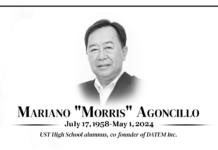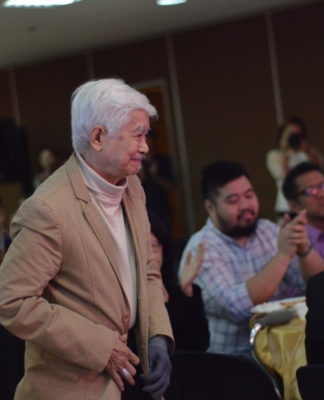“I THINK Thomasians are lacking when it comes to their spirituality. There was a low turnout nuong nagkaroon ng Mass for the freshman, but the party was well-attended.”
This was what Marlo Trillana, president of the Marian Evangelistic Community (MEC), said regarding the disheartening reception by the Thomasian community of religious-oriented organizations. The groups are perceived as organizers of retreats, prayer meetings, and bible studies, hardly “fun” fare for young and vibrant students eager for a good time amid the drudgery and pressure of schoolwork.
Conveying God’s words and looking after the spiritual welfare of the Thomasian community are the main thrusts of the religious organizations in the campus. They form the Student Religious Organization (SRO) network that reaches out to students seeking a second home amid the academic pressures in the university.
Conceived in 1995, the SRO is composed of the Marian Evangelization Community (MEC), Pax Romana, Christ Youth in Action (CYA), and CFC Youth for Christ (YFC), all under the supervision of the Center for Campus Ministry (CCM) under the Office of the Vice-Rector for Religious Affairs.
Being the umbrella organization, CCM envisions itself to be a place conducive for prayer, reflection, and personal conversion. It holds liturgical and para-liturgical services to enhance campus spirituality. It supports the SROs in promoting Catholic ideals. It provides the four SRO’s with recollections, retreats, and bible studies. In short, it takes care of the spirituality of religious organizations that are supposed to promote the spirituality of young students.
But alas, SRO’s have more basic things to address other than spirituality. They must, for instance, address the question of survival. Six years ago, there were 10 SRO’s. Today there are only four. MEC, which promotes Marian devotion through the performing arts, is on the brink of disintegration for lack of members and lack of funds.
“We are approaching our tenth year. If that (dissolution) is God’s will, then we can’t do anything but accept it. We will still try to give our best,” Trillana said.
Is it God’s will then that SRO’s die a natural death?
Diminishing spirituality
Ironically, a study conducted only seven years ago painted a positive picture of Thomasian religiosity. The 1995 study by the UST Social Research Center among UST students showed that majority of the respondents (69.3 percent) considered themselves “religious”. Only 2.4 percent said they were “not religious.”
The study explained that beliefs and values are difficult to assess but attempts were made to evaluate a person’s religiosity through their answers to the questionnaire. The personal stand of a student on sensitive issues was assumed to be reflective of her moral values. Results showed that Thomasians manifested a strong adherence to the key teachings of the Church such as the existence of God, Jesus Christ, life after death, and the Virgin Mary. Extra-marital affairs, abortion, adultery, vote buying, homosexual affairs, and bribery were viewed unfavorably by the respondents.
Furthermore, majority of the respondents said they observed religious practices such as attending Mass, going to communion and confession, praying the rosary, reading the Bible. In addition, respondents said they recited private prayers and Novenas, and make religious pilgrimage and special sacrifices.
What has happened since 1995?
A controversial recent study at the Ateneo de Manila University showed an alarming increase in the number of young Filipinos who do not believe “in life after death.” It also showed a growing ignorance or lack of interest among young people of bedrock Catholic beliefs and practices.
Looking back, perhaps part of the reason for the large number of young Thomasians who considered themselves religious was the impending visit of Pope John Paul II in 1995 for the World Youth Day that Manila hosted. UST itself hosted the International Youth Forum, the congress of young leaders during World Youth Day, and was rewarded with a second visit by the present Pontiff (he first visited UST in 1981). Excitement over the papal visit might have contributed to the renewed spiritual fervor among young Thomasians.
Since then of course, the euphoria has died down. But the drastic decrease in the number of SRO’s from 10 in 1995 to just four this year is alarming, indeed.
In a way, even the establishment of the Center Campus Ministry had already boded the dramatic drop in Thomasian religiosity. Observers have noted that a campus ministry office in a Catholic school is an anomaly. Only non-sectarian schools have campus ministry offices to take care of the religious needs of their students and employees, observers said.
And if the CCM were created to improve Thomasian religiosity, going by the dwindling number of SRO’s, then it might be doing a not too successful job at it.
Braving the odds
Part of the problem of survival of SRO’s is financial.
Trillana said MEC finds it hard to raise money. “The other organizations are subsidized by their parent organization. Kami, hindi. So our members really have to work for it,” he said.
Cris Moreno, CYA chairman, also shared the same problem. He said that CYA is a non-profit organization. “We are also not college-based so we cannot solicit from members in different colleges. Part of our funds also came from solicitations from alumni members and sponsors,” Moreno said.
Because it is the youth arm of the large national and even international Catholic organization Couples for Christ, YFC does not really have grave financial problems, its president, Angel Perez, said. “Minsan nga hindi rin naming alam kung paano din kami nagkakaroon ng funds. Basta dumadating na lang.”
Pax Romana, the oldest and most established UST SRO, also does not have funding problems. Analyn Angus, Pax Romana president, said money is the least of the group’s problem.
Money should not be a big problem, according to the CCM. “We are more focused on how to be effective in doing ministry work rather than worry about the budget. Sometimes, people tend to become paranoid when money is involved,” said Albert Loteyro of the CCM.
If money is really not a problem, then the main problem for SRO’s and the CCM may be organizational. Lack of student participation has been a perennial problem of the SRO.
“Sometimes even the coordinators fail to update new members on the latest activities. Unless they (members) really have initiative to inquire doon lang nila malalaman na may ganitong activity. Manpower-wise outnumbered kami,” Trillana said.
Khyme Estaban, YFC vice-president for evangelization and a senior AB Behavioral Science student, said that there are some students who have difficulty in handling school activities while in YFC.
“Minsan nagba-backslide sila. Masaya kasi sa YFC, kaya nakakalimutan nilang i-prioritize iyong studies nila,” she said.
According to Angus, there are also students who join SRO’s just to have something to put in their credentials. There are even cases wherein there are a lot of members who registered in a certain SRO but become inactive.
Ignorance and apathy
In a way, many enter the University without knowing its Catholic character and mission. At the least, what they know merely is the surface trapping of Christianity, not its essence. And the UST may be remiss in initiating them to the real experience of Christiarnity.
Marie Pauline Zarate , MEC president and senior Nursing student, said that many Thomasians are not even familiar with their respective college regents. “Iyong iba nakikita lang sila kung mayroong Mass,” she added. In some instances, students don’t know who the Dominicans are.
Of course, the regents themselves may be blamed for the gross religious ignorance of some students. Some don’t make themselves visible. Students complain that they only see their regents during the once-a-year recollection. Other students say their regents seem remote and don’t bother to establish rapport with them.
In a way, the faculty members themselves abet the ignorance and illiteracy on spiritual and moral matters of the students. Some students have complained of the allegedly boring or ineffective Theology classes under the Institute of Religion. Others have complained about professors who are ignorant of the Church and of UST history despite having taught in the University for a long time. Some students say their Theology teachers can’t even identify, much less explain, the statues in front of the UST Central Library (the statues depict San Lorenzo Ruiz and his martyred companions, many of whom were teachers and alumni of UST).
Still others cite teachers who openly criticize or ridicule key Church teachings and even demean the University. One professor, according to a student, said there’s nothing wrong with abortion and the usual guilt ascribed to its commission may be banished by a warm bath. Another reportedly bragged about the Master’s degree he obtained from UP and criticized UST for its “medieval thinking.” A student said the professor was at the least guilty of intellectual dishonesty for teaching in UST and getting paid for it while ridiculing it.
Textbooks being used in the history and Rizal courses parrot the ultra-liberal discourse against UST’s colonial past, including the myth that Rizal was persecuted in UST, which has already been demolished by historiography. In some instances, the textbooks are published by UST.
These and other influences may have dampened the religious fervor of young Thomasians. Lejempf Flores, former MEC president, said that Thomasians are affected by societal influences, in and out of the campus.
“One cannot easily gauge a person’s spirituality,” Loteyro said. “You cannot just evaluate it. Once you plant a seed in the lives of these people, whether they accept it or not, we can only hope that they will grow with the Lord.”
“In general, hindi naman decline because the religious organizations is just one of the expression of Thomasian spirituality,” Carmelo Arada Jr., a second-year theology student of the Central Seminary, said. “I attend college masses always and I witness the active participation of the students. We cannot gauge the decline in terms of the number of participants of religious organization.”
But Arada said lax religiosity, if it exists on campus, must be considered a great challenge to the Thomasian community and the Church. He explained there is a need for renewed evangelization, which would not view media as an evil force but as something that could be utilized in reaching out to the people. “The Church can use the modern means of communication, which would appeal to the younger generation,” he said. “Recently, the Vatican has published a document on the impact of Internet. Without necessary breaking up the tradition, we should come up with innovative means to present Jesus to others. Thomasians should keep in mind that there are worldly pleasures that are only transitory and it is only in Jesus that they can experience authentic happiness,” he said.














